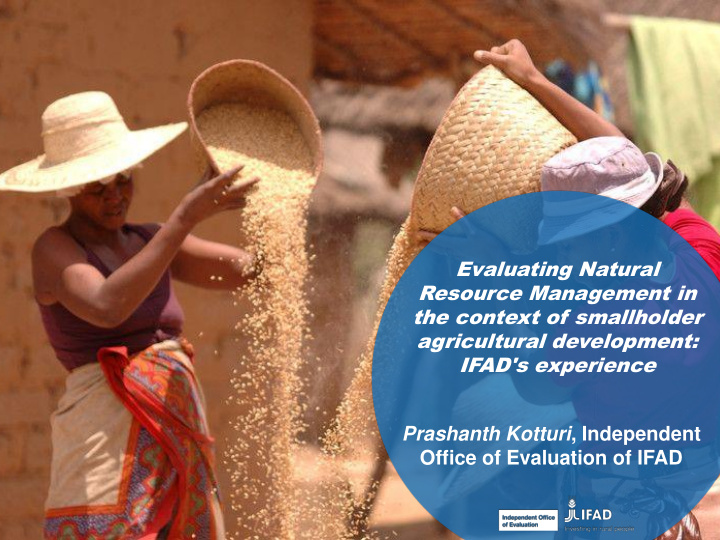



Evaluating Natural Resource Management in the context of smallholder agricultural development: IFAD's experience Prashanth Kotturi , Independent Office of Evaluation of IFAD
Pur Purpo pose se of of th the p e prese esent ntatio tion • Share the journey of institutional thinking of the International Fund for Agricultural Development (IFAD) on environment and natural resource management and Independent Office of Evaluation (IOE) on evaluating environment and natural resource management (henceforth referred to as ENRM) • Deliberate on the methods and methodology that accompanied such evolution • Learn from others on their experiences 2
IF IFAD AD an and significan d significance ce of of ENRM ENRM to to i its ts wor ork • IFAD, an IFI focussing on agricultural and rural development • Environment and natural resource management play an intrinsic role in agriculture sector. • Climate change has added to complexity of ENRM and the manner in which issues around it need to be addressed • Evaluating ENRM has evolved accordingly 3
Evolution of NRM in IFAD IFAD strategy 2007-10 IFAD strategy 2011-15 IFAD strategy 2016-25 Objective Poor rural men and women A strengthened natural Strengthen the are able to sustainably and resource and economic environmental efficiently utilize and manage asset base for poor rural sustainability and natural resources such as women and men that is climate resilience of poor land and water more resilient to climate rural change , environmental people’s economic degradation and market activities transformation Nature of Explicit focus on access to Recognition in the Recognition in the recognition of natural resources for context of climate context of climate ENRM productive activity. No change change and resilience mention of climate change in the objectives Thematic focus Not mentioned Environment and climate Environment and climate change mentioned as change mentioned as thematic areas of focus thematic areas of focus 4
Changes in institutional setup • Establishment of environment and climate division for mainstreaming • Inclusion of indicators pertaining to ENRM in IFAD’s results measurement framework • Harmonization agreements between IOE and IFAD management signed mean that ENRM was also incorporated into the self-evaluation systems • Regional climate and environment specialists appointed to mainstream ENRM and climate change into IFAD programming. 5
Evolution of evaluation methodology on ENRM • Taken out of rural • Part of rural poverty impact poverty impact domain criteria Evaluation Manual- • Separate • Not rated First Edition (2009) performance criteria separately alongside climate change adaptation • Two overarching • Retained as part of • Retained guiding questions rural poverty impact mainstreaming into domain sustainability Methodology • Hived off into framework for Project • Six key questions separate criteria Evaluation (2003) • Rated separately Evaluation Manual- • Explicit recognition Second Edition (2015) of ENRM in sustainability 6
Evaluation Questions Methodology Evaluation Manual-First Evaluation Manual-Second Edition framework for Project Edition (2009) (2015) Evaluation (2003) Change in status of the Change in status of the Extent of project’s adoption of natural resources base natural resources base approaches/measures for restoration or sustainable management of natural resources Change in exposure to Change in communities’ Extent to which project developed the environmental risks access to natural capacity of community groups and institutions resources to manage environmental risks Change in the degree of Contribution to reducing the environmental environmental vulnerability of communities and building vulnerability resilience Contribution to long-term environmental and social sustainability Following required environmental and social risk assessment procedures 7
Accumulated knowledge on ENRM • Body of evaluation knowledge and rating in ENRM to report on trends and performance at corporate level in the form of Annual Report on Results and Impact (ARRI) • 2016: Evaluation Synthesis of IFAD’s support to Environment and Natural Resource Management. A synthetic analysis of accumulated evaluative evidence over the years on the topic. • 2020(foreseen): Thematic evaluation of IFAD’s contribution to smallholder adaptation to climate change 8
Methods for collection of ENRM data • Historically, dependence on the self-evaluation data, mostly qualitative in nature. – Validation based on field visits: Interviews, group discussions, observations in the target communities. Proxy indicators when interacting with communities. • In light of higher recognition in strategic framework and gradual mainstreaming of ENRM, IOE has experimented with newer methods . • Remote Sensing presents a new way of assessing achievement on ENRM. Use of Normalized Difference Vegetation Index (NDVI), as a quantitative measure for triangulation. Scope for quick and simple triangulation . Helpful for site selection . • New impact evaluation on a community based natural resource management programme in Ethiopia will collect statistically significant quantitative data on specific ENRM related indicators. Likely to be access based indicators. 9
Example of satellite imagery used 10
Some constraints in using newer methods • Limited expertise in-house on new methods available. Need to hire short-term specialist • Transaction and opportunity costs of using GIS tools. Impact evaluations are highly expensive • Lack of mainstreaming of technology into operational work. E.g. Sites not geotagged during implementation. • May help you answer “What” question, it doesn’t help in answering the “Why” question. 11
Conclusions • IFAD and IOE’s understanding have evolved. So has the nature of interventions. • Move away from ENRM in a standalone manner to emphasis in the context of resilience and climate change • This evolution calls for newer methods beyond usual qualitative methods. • IOE has been experimenting with usage of newer methods such as GIS for low cost acquisition of quantitative data. 12
Thank you for your attention 13
Recommend
More recommend